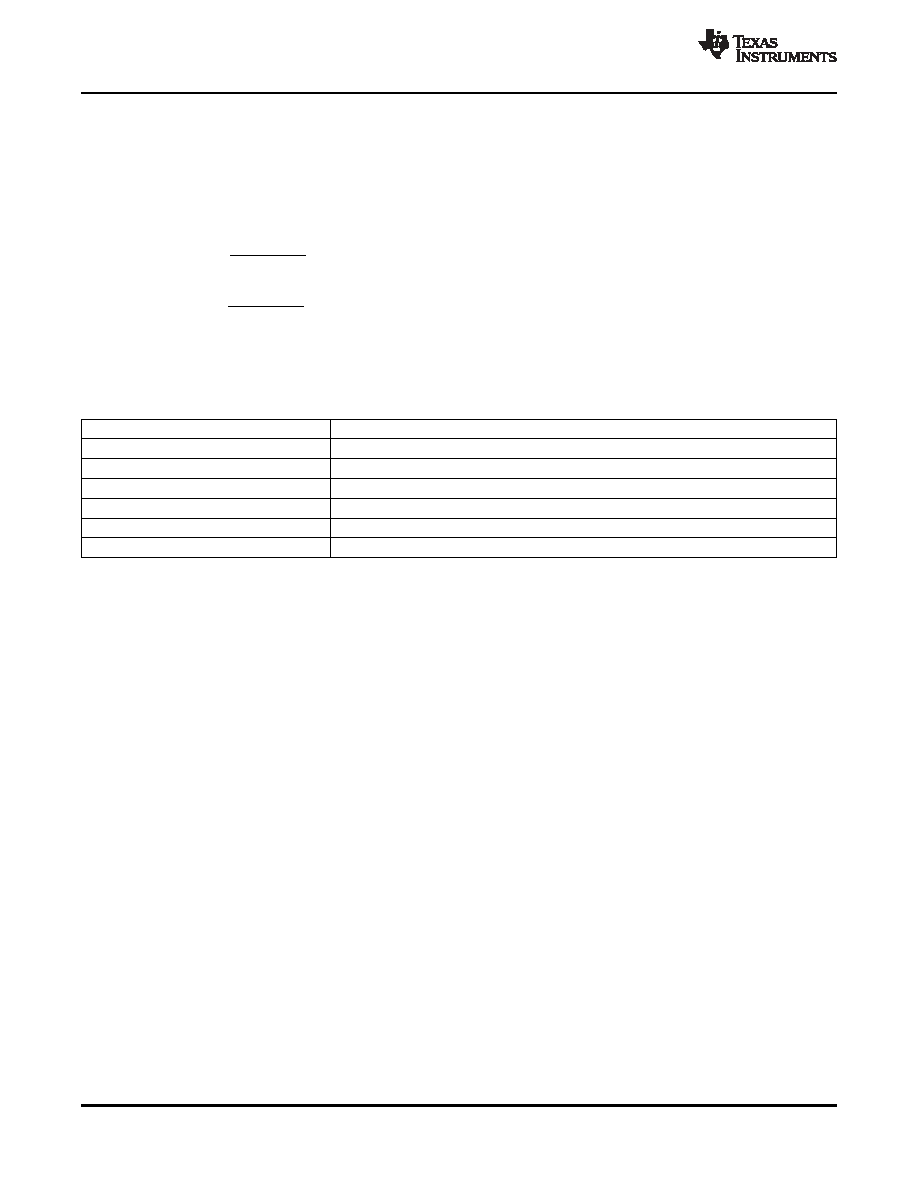- 您現(xiàn)在的位置:買賣IC網(wǎng) > PDF目錄98254 > TLV320AIC36IZQE (TEXAS INSTRUMENTS INC) SPECIALTY CONSUMER CIRCUIT, PBGA80 PDF資料下載
參數(shù)資料
| 型號: | TLV320AIC36IZQE |
| 廠商: | TEXAS INSTRUMENTS INC |
| 元件分類: | 消費(fèi)家電 |
| 英文描述: | SPECIALTY CONSUMER CIRCUIT, PBGA80 |
| 封裝: | 5 X 5 MM, GREEN, PLASTIC, VFBGA-80 |
| 文件頁數(shù): | 114/165頁 |
| 文件大小: | 1895K |
| 代理商: | TLV320AIC36IZQE |
第1頁第2頁第3頁第4頁第5頁第6頁第7頁第8頁第9頁第10頁第11頁第12頁第13頁第14頁第15頁第16頁第17頁第18頁第19頁第20頁第21頁第22頁第23頁第24頁第25頁第26頁第27頁第28頁第29頁第30頁第31頁第32頁第33頁第34頁第35頁第36頁第37頁第38頁第39頁第40頁第41頁第42頁第43頁第44頁第45頁第46頁第47頁第48頁第49頁第50頁第51頁第52頁第53頁第54頁第55頁第56頁第57頁第58頁第59頁第60頁第61頁第62頁第63頁第64頁第65頁第66頁第67頁第68頁第69頁第70頁第71頁第72頁第73頁第74頁第75頁第76頁第77頁第78頁第79頁第80頁第81頁第82頁第83頁第84頁第85頁第86頁第87頁第88頁第89頁第90頁第91頁第92頁第93頁第94頁第95頁第96頁第97頁第98頁第99頁第100頁第101頁第102頁第103頁第104頁第105頁第106頁第107頁第108頁第109頁第110頁第111頁第112頁第113頁當(dāng)前第114頁第115頁第116頁第117頁第118頁第119頁第120頁第121頁第122頁第123頁第124頁第125頁第126頁第127頁第128頁第129頁第130頁第131頁第132頁第133頁第134頁第135頁第136頁第137頁第138頁第139頁第140頁第141頁第142頁第143頁第144頁第145頁第146頁第147頁第148頁第149頁第150頁第151頁第152頁第153頁第154頁第155頁第156頁第157頁第158頁第159頁第160頁第161頁第162頁第163頁第164頁第165頁

1
15
1
0
HPF
z
D
2
z
N
)
z
(
H
-
+
=
1
15
1
0
LPF
z
D
2
z
N
)
z
(
H
-
+
=
SBAS387A – MAY 2009 – REVISED JUNE 2010
www.ti.com
The DRC typically works on the filtered version of the input signal. The input signals have no audio
information at DC and extremely low frequencies; however they can significantly influence the energy
estimation function in DRC. Also most of the information about signal energy is concentrated in the low
frequency region of the input signal.
To estimate the energy of the input signal, the signal is first fed the DRC high-pass filter, and then fed to
the DRC low-pass filter. These filters are implemented as first-order IIR filters given by
(11)
(12)
The coefficients for these filters are 16 bits wide in twos complement and are user programmable through
register write as given in Table 5-18
Table 5-18. DRC HPF and LPF Coefficients
Coefficient
Location
HPF N0
C71 Page 9, Register 14 and 15
HPF N1
C72 Page 9, Register 16 and 17
HPF D1
C73 Page 9, Register 18 and 19
LPF N0
C74 Page 9, Register 20 and 21
LPF N1
C75 Page 9, Register 22 and 23
LPF D1
C76 Page 9, Register 24 and 25
The default values of these coefficients implement a high-pass filter with a cut-off at 0.00166*DAC_FS,
and a low-pass filter with a cutoff at 0.00033 * DAC_FS.
The output of the DRC high-pass filter is fed to the Processing Block selected for the DAC Channel. The
absolute value of the DRC-LPF filter is used for energy estimation within the DRC.
The gain in the DAC Digital Volume Control is controlled by Page 0, Register 65 and 66. When the DRC is
enabled, the applied gain is a function of the Digital Volume Control register setting and the output of the
DRC.
The DRC parameters are described in sections that follow.
5.13.2.1 DRC Threshold
The DRC Threshold represents the level of the DAC playback signal at which the gain compression
becomes active. The output of the digital volume control in the DAC is compared with the set threshold.
The threshold value is programmable by writing to register Page 0, Register 68, D(4:2). The Threshold
value can be adjusted between –3 dBFS to –24 dBFS in steps of 3 dB. Keeping the DRC Threshold value
too high may not leave enough time for the DRC block to detect peaking signals, and can cause
excessive distortion at the outputs. Keeping the DRC Threshold value too low can limit the perceived
loudness of the output signal.
The recommended DRC-Threshold value is –24 dB.
When the output signal exceeds the set DRC Threshold, the interrupt flag bits at Page 0, Register 44,
D(3:2) are updated. These flag bits are 'sticky' in nature, and are reset only after they are read back by the
user. The nonsticky versions of the interrupt flags are also available at Page 0, Register 46, D(3:2).
5.13.2.2 DRC Hysteresis
DRC Hysteresis is programmable by writing to Page 0, Register 68, D(1:0). It can be programmed to
values between 0 dB and 3 dB in steps of 1 dB. It is a programmable window around the programmed
DRC Threshold that must be exceeded for a disabled DRC to become enabled, or an enabled DRC to
52
APPLICATION INFORMATION
Copyright 2009–2010, Texas Instruments Incorporated
Product Folder Link(s): TLV320AIC36
相關(guān)PDF資料 |
PDF描述 |
|---|---|
| TLV320DAC23IPW | SERIAL INPUT LOADING, 32-BIT DAC, PDSO28 |
| TLV320DAC23IGQER | SERIAL INPUT LOADING, 32-BIT DAC, PBGA80 |
| TLV320DAC23PWR | SERIAL INPUT LOADING, 32-BIT DAC, PDSO28 |
| TLV320DAC23RHDR | SERIAL INPUT LOADING, 32-BIT DAC, PQCC28 |
| TLV320DAC23RHDG4 | SERIAL INPUT LOADING, 32-BIT DAC, PQCC28 |
相關(guān)代理商/技術(shù)參數(shù) |
參數(shù)描述 |
|---|---|
| TLV320AIC36IZQER | 功能描述:接口—CODEC Low Pwr Stereo Aud Codec RoHS:否 制造商:Texas Instruments 類型: 分辨率: 轉(zhuǎn)換速率:48 kSPs 接口類型:I2C ADC 數(shù)量:2 DAC 數(shù)量:4 工作電源電壓:1.8 V, 2.1 V, 2.3 V to 5.5 V 最大工作溫度:+ 85 C 安裝風(fēng)格:SMD/SMT 封裝 / 箱體:DSBGA-81 封裝:Reel |
| TLV320ALC23 | 制造商:TI 制造商全稱:Texas Instruments 功能描述:Evaluation Platform for the TLV320ALC23 Stereo Audio CODEC and TLV230DAC23 Stereo DAC |
| TLV320ALC31 | 制造商:BB 制造商全稱:BB 功能描述:LOW POWER STEREO AUDIO CODEC FOR PORTABLE AUDIO/TELEPHONY |
| TLV320DA26IRHBG4 | 功能描述:音頻數(shù)/模轉(zhuǎn)換器 IC Lo-Pwr Ster DAC w/Hdphn/Spkr Amp RoHS:否 制造商:Texas Instruments 轉(zhuǎn)換器數(shù)量: 分辨率:16 bit 接口類型:I2S, UBS 轉(zhuǎn)換速率: 信噪比:98 dB 工作電源電壓:5 V DAC 輸出端數(shù)量:2 工作溫度范圍:- 25 C to + 85 C 電源電流:23 mA 安裝風(fēng)格:SMD/SMT 封裝 / 箱體:TQFP-32 封裝:Reel |
| TLV320DAC23 | 制造商:TI 制造商全稱:Texas Instruments 功能描述:STEREO AUDIO D/A CONVERTER, 8-TO 96KHZ WITH INTERGRATED HEADPHONE AMPLIFIER |
發(fā)布緊急采購,3分鐘左右您將得到回復(fù)。